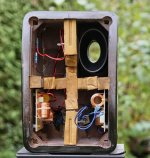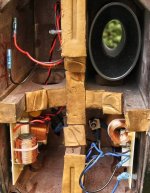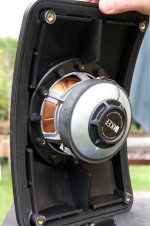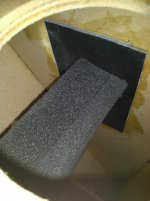https://permalideho.co.uk/products/Yes, i'm talking about plywood, i still have some old mahogany plywood parts (all layers are made of perfect sheets of beautiful mahogany), the best looking ones (AAA+ grades) were 10 times more expensive than the normal retail price and the most beautiful were negotiated... do you see what i mean
https://www.bkbindustrial.com/delignit-panzerholz
I might be missing it in this thread, but regarding panel absorbers, the size of the gap (and the applied acoustic absorption in it) between panel and underlying construction is of critical importance to it's effectiveness and frequency range. Much more so than which green glue to apply.Truth be told, in-wall applications I'd be doing double layer 1/2" sheetrock with green glue and call it done. The larger scale you can apply the technique the greater the overall efficacy, especially because you need large surface area to effectively couple the low frequency content into the walls. A worse solution applied more completely to the room yields an overall superior end result. That was your original plan and I thought it quite sensible. You can evaluate where you stand after that is done, especially because any further modification would be after the paint is dry and furniture is placed -- all the things which will make a material difference in room behavior.
As an academic note, the moment of inertia of each respective side will play a role as well, so a stiffer 1/4" material will behave quite differently in flex (and it must flex if there is to be shear, but to what degree) than 1/2" material even if they match E*S, as you specify. The easiest and best way without getting lost in the weeds is to have identical panels around your shear layer.
Tell us how it goes!
Yes. it is incredibly complex to optimize, but even suboptimal it's still a good technique. From what I have seen of green glue, I was not impressed. I used a 2k filled poly which I found works very well.... the size of the gap (and the applied acoustic absorption in it) between panel and underlying construction is of critical importance to it's effectiveness and frequency range. Much more so than which green glue to apply.
I've been out of it for a long time, and had to give the whole thread a re-read. Technically, I can't argue with your position at all. I think my early argument was "do something and don't sweat it too much" as far as finishing up a house/room remodel more than trying to give optimal engineering advice.I might be missing it in this thread, but regarding panel absorbers, the size of the gap (and the applied acoustic absorption in it) between panel and underlying construction is of critical importance to it's effectiveness and frequency range. Much more so than which green glue to apply.
Am I right in thinking that your CLD bracing method uses a highly damped adhesive only where the cross braces intersect and is fixed rigidly at the cabinet walls?I used several techniques, all of them based on Constrained Layer Damping (CLD) concepts. There is also the fact that the materials that I used were highly damped (polyurethane boards) - unlike common materials (MDF etc.) used in speaker construction. The front panel and rear panels were both CLD. I also fabricated a cross brace from front to back and side to side (the four largest area panels) fixed in the center. I say fixed, but this brace is also CLD being made of long flat pieces that only connect to each other via a highly damped polyurethane glue (non-hardening.) By far the most effective means of controlling cabinet radiation is to structurally damp the cabinet. I used a small amount of internal damping material, but I never viewed that as being very effective.
Do these braces affix to the outer cabinet walls or the inner CLD panels on the front/rear baffles?
The Kef approach for CLD bracing as used in the LS50, appears to be constructed with two rigid interlocking window braces that interface with all cabinet walls but separated by a damped mastic layer.
Looking at the attached photos, this material appears to be at least 3mm thick and has seemingly undergone plastic deformation when the front baffle presses against it.
Any idea what damping material Kef used?
Does CLD bracing require one rigid and one damped fixing point?
Attachments
Last edited:
I have been reading another thread with a useful image.
https://www.diyaudio.com/community/...y-bracing-question.360334/page-2#post-6348953
The method in that particular post and also attached image seemingly demonstrates cross bracing/damping in shear, whereas the Kef LS50 is using matrix bracing/damping in tension?
Would it be beneficial to combine both methods i.e the two strips of wood glued together with high damping adhesive (shear) and then fix the brace to the speaker cabinet walls with a damping layer (tension) as in the second image from the same thread above?
https://www.diyaudio.com/community/...y-bracing-question.360334/page-2#post-6348953
The method in that particular post and also attached image seemingly demonstrates cross bracing/damping in shear, whereas the Kef LS50 is using matrix bracing/damping in tension?
Would it be beneficial to combine both methods i.e the two strips of wood glued together with high damping adhesive (shear) and then fix the brace to the speaker cabinet walls with a damping layer (tension) as in the second image from the same thread above?
Attachments
Last edited:
Am I right in thinking that your CLD bracing method uses a highly damped adhesive only where the cross braces intersect and is fixed rigidly at the cabinet walls?
They are rigidly fixed to the side walls and the baffle and rear panel (both of which are CLD.)Do these braces affix to the outer cabinet walls or the inner CLD panels on the front/rear baffles?
Basically yes, although all connections could be damped, it's just not really necessary as long as there is one connection damped.Does CLD bracing require one rigid and one damped fixing point?
- Home
- Loudspeakers
- Multi-Way
- Constrained Layer Damping to Absorb Bass – Geddes




